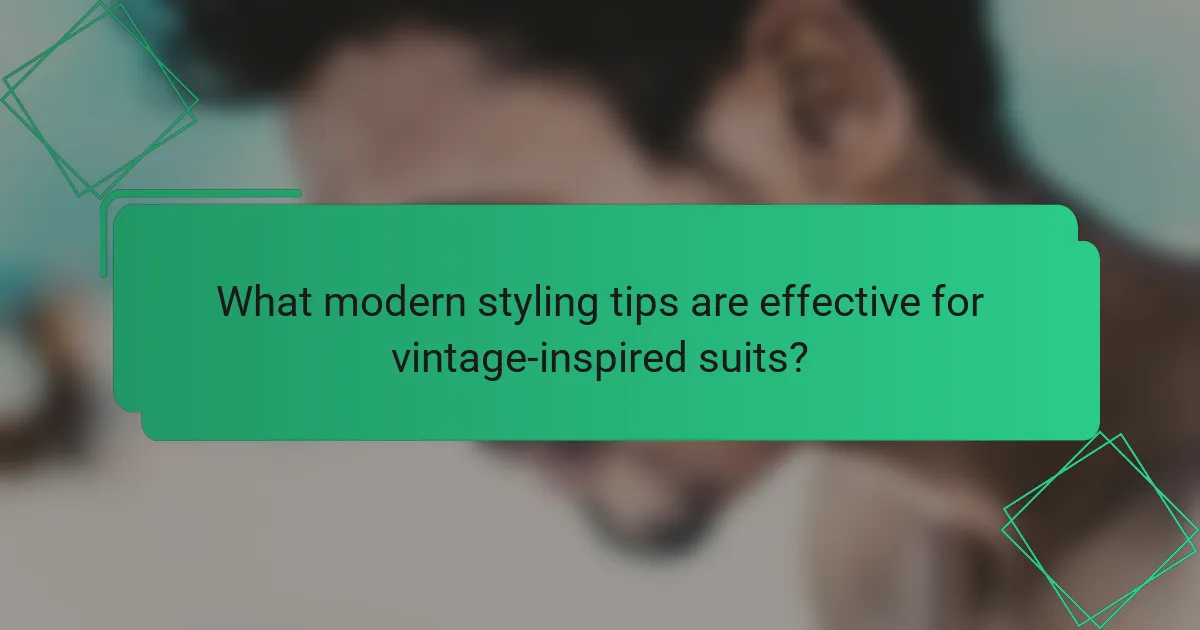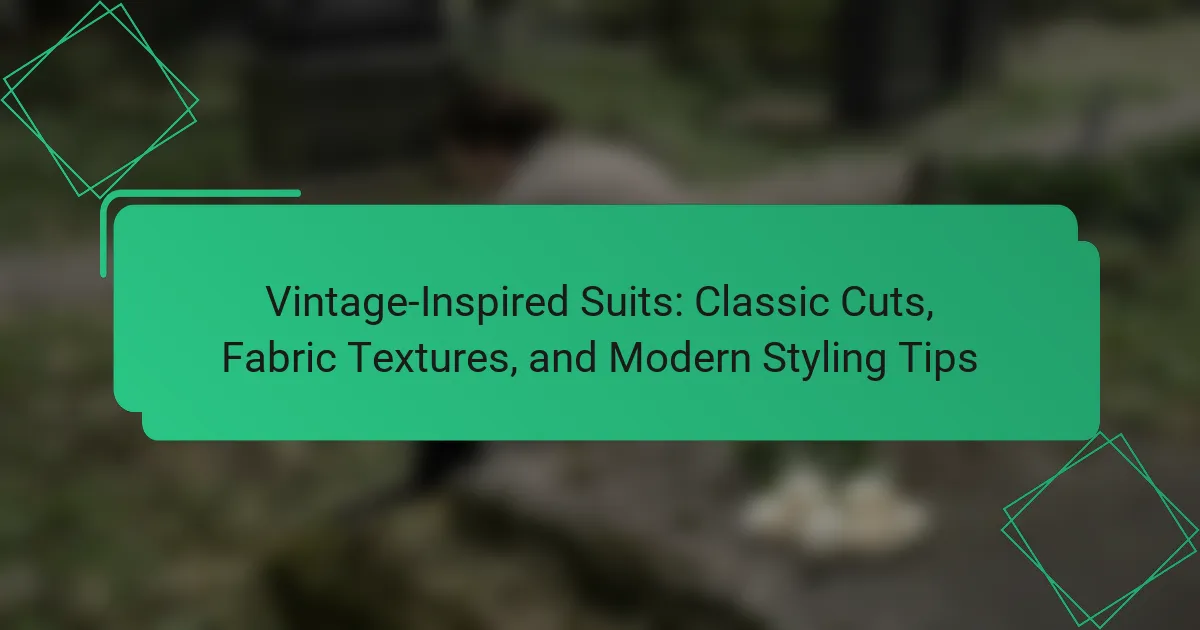Vintage-inspired suits are garments that incorporate design elements from past fashion eras, specifically from the 1920s to the 1970s. These suits feature classic cuts, such as high-waisted trousers and tailored blazers, and often utilize traditional fabrics like wool, tweed, and linen, along with distinctive patterns such as houndstooth and pinstripes. The article explores the appeal of these suits, highlighting their unique style, comfort, and versatility for various occasions. Additionally, it provides modern styling tips, including pairing with contemporary accessories and incorporating fitted shirts and tailored overcoats to enhance the overall look while maintaining a vintage aesthetic.

What are Vintage-Inspired Suits?
Vintage-inspired suits are garments that draw design elements from past fashion eras, primarily the 1920s to the 1970s. These suits typically feature classic cuts, such as high-waisted trousers and tailored blazers. They often utilize traditional fabric textures, including wool, tweed, and linen. Vintage-inspired suits may also incorporate distinctive patterns like houndstooth or pinstripes. The appeal lies in their nostalgic aesthetic combined with modern fit and styling. This fusion allows wearers to express individuality while honoring historical fashion. Such suits are popular for events, weddings, and formal occasions, reflecting a timeless elegance.
How did vintage-inspired suits evolve over time?
Vintage-inspired suits evolved from traditional styles to contemporary interpretations. Initially, suits in the early 20th century emphasized structured silhouettes and classic fabrics. The 1920s introduced more relaxed fits and patterns, reflecting social changes. By the mid-20th century, suits incorporated vibrant colors and unique textures. In the 1970s, styles became more eclectic, with bold patterns and wider lapels. The revival of vintage aesthetics in the 1990s led to a resurgence of classic cuts with modern tailoring. Today, vintage-inspired suits blend traditional elements with contemporary fashion trends, appealing to a diverse audience. This evolution mirrors broader cultural shifts and changing fashion sensibilities over the decades.
What historical fashion trends influenced vintage-inspired suits?
Vintage-inspired suits are influenced by several historical fashion trends. The 1920s introduced the tailored silhouette with sharp lapels and high-waisted trousers. The 1930s saw the popularity of double-breasted jackets and wide shoulders, emphasizing a strong masculine figure. The 1940s brought in utilitarian styles due to wartime fabric restrictions, leading to simpler designs and functional pockets. The 1950s redefined elegance with fitted suits and softer fabrics, often featuring bold patterns. Each of these decades contributed distinct elements that are now celebrated in vintage-inspired suits.
How do vintage-inspired suits differ from contemporary styles?
Vintage-inspired suits feature classic cuts and traditional fabrics. They often emphasize structured shoulders and tapered waists. Contemporary styles focus on relaxed fits and modern materials. Vintage designs may include details like peak lapels and double-breasted jackets. Contemporary suits often embrace minimalism and simplicity. The color palettes differ as well; vintage suits tend to use muted tones. In contrast, contemporary suits may incorporate bold colors and patterns. Historical context shows that vintage styles reflect fashion trends from specific eras, such as the 1950s or 1970s.
What are the key characteristics of vintage-inspired suits?
Vintage-inspired suits are characterized by their classic cuts, unique fabric textures, and retro detailing. These suits often feature high-waisted trousers and fitted blazers that reflect styles from the mid-20th century. Common fabric choices include wool, tweed, and linen, which provide a timeless aesthetic. Vintage-inspired suits frequently incorporate distinctive elements such as peaked lapels, double-breasted designs, and bold patterns like houndstooth or plaid. The color palette tends to favor muted tones, pastels, or rich jewel tones that evoke a nostalgic feel. Additionally, attention to craftsmanship and tailoring is paramount, ensuring a flattering fit that is reminiscent of historical styles. This combination of attributes makes vintage-inspired suits a popular choice for those seeking a blend of classic elegance and contemporary flair.
What classic cuts are commonly found in vintage-inspired suits?
Classic cuts commonly found in vintage-inspired suits include the double-breasted suit, the single-breasted suit, and the three-piece suit. The double-breasted suit features a wider lapel and overlapping front flaps. This cut was popularized in the 1920s and 1930s. The single-breasted suit is characterized by one row of buttons and a more streamlined silhouette. It became a staple in men’s fashion during the mid-20th century. The three-piece suit consists of trousers, a jacket, and a waistcoat. This ensemble was favored for its versatility and elegance. Each of these cuts reflects distinct historical styles that are often revived in modern fashion.
What fabric textures are typical for vintage-inspired suits?
Typical fabric textures for vintage-inspired suits include tweed, houndstooth, and corduroy. Tweed is a classic choice known for its durability and warmth. Houndstooth features a distinctive broken check pattern, adding visual interest. Corduroy has a ribbed texture that provides a unique feel and appearance. Wool is often used for its breathability and softness. Linen is favored for warm weather due to its lightweight nature. These textures reflect styles from different vintage eras, enhancing the retro aesthetic.

What are the benefits of wearing vintage-inspired suits?
Wearing vintage-inspired suits offers several benefits. They provide a unique style that stands out in modern fashion. Vintage-inspired suits often feature classic cuts that enhance body shape. The use of high-quality fabrics ensures durability and comfort. Many vintage styles are timeless, making them versatile for various occasions. Wearing these suits can evoke a sense of nostalgia and sophistication. Additionally, they often reflect individuality, allowing wearers to express personal style. Historical fashion trends can also influence contemporary looks, merging past elegance with modern aesthetics.
How do vintage-inspired suits enhance personal style?
Vintage-inspired suits enhance personal style by incorporating classic designs and unique fabric textures. These suits often feature tailored fits that flatter the body. They draw inspiration from past fashion eras, adding a timeless quality to modern wardrobes. Vintage-inspired suits can showcase distinctive patterns, colors, and materials that stand out. This uniqueness allows individuals to express their personality and creativity. Wearing such suits can evoke nostalgia, connecting the wearer to historical fashion trends. Statistics show that vintage fashion has seen a resurgence, with many consumers seeking individuality in their clothing choices. Overall, vintage-inspired suits serve as a stylish bridge between past and present fashion.
What occasions are best suited for vintage-inspired suits?
Vintage-inspired suits are best suited for formal events, weddings, and themed parties. These occasions allow for the unique style and elegance of vintage tailoring to shine. Formal events often call for sophisticated attire, making a vintage suit an excellent choice. Weddings frequently embrace vintage themes, where such suits can complement the overall aesthetic. Themed parties, especially those centered around specific decades, are perfect for showcasing vintage-inspired fashion. Additionally, vintage suits can be worn at cocktail parties and upscale gatherings, where a classic look is appreciated.
How can vintage-inspired suits boost confidence and self-expression?
Vintage-inspired suits can boost confidence and self-expression through their unique styles and historical significance. These suits often feature distinct cuts and patterns that stand out in contemporary fashion. Wearing a vintage-inspired suit allows individuals to express their personality and taste. This form of attire can evoke a sense of nostalgia and connection to past eras. Studies show that clothing can influence self-perception and social interactions. A vintage suit can enhance feelings of individuality and authenticity. The tailored fit of these suits often improves posture, contributing to a more confident demeanor. Overall, vintage-inspired suits serve as a powerful medium for personal expression and self-assurance.
What should one consider when selecting a vintage-inspired suit?
When selecting a vintage-inspired suit, one should consider the cut, fabric, and fit. The cut defines the suit’s silhouette, which can range from tailored to relaxed. Fabrics like wool, tweed, and linen are traditional choices that reflect vintage styles. The fit is crucial; it should be comfortable while maintaining the vintage aesthetic. Additionally, color and pattern play a significant role. Classic patterns include houndstooth and pinstripes, often associated with vintage suits. Accessories can enhance the vintage look, such as pocket squares or vintage ties. Finally, ensure that the suit aligns with the era you wish to emulate, whether it’s the 1920s or 1970s.
What are the essential fit considerations for vintage-inspired suits?
Essential fit considerations for vintage-inspired suits include shoulder fit, waist contour, and sleeve length. The shoulders should align with the natural shoulder line without any overhang. A tailored waist creates a flattering silhouette, often seen in vintage styles. Sleeve length should allow for a slight reveal of the shirt cuff, typically around half an inch. Additionally, the jacket length should cover the seat while maintaining proportion with the wearer’s height. Trouser fit is crucial; they should sit comfortably at the waist and taper slightly towards the ankle. Overall, these fit elements ensure a classic, polished appearance that reflects vintage aesthetics.
How do fabric choices impact the overall look of a vintage-inspired suit?
Fabric choices significantly impact the overall look of a vintage-inspired suit. Different fabrics convey distinct aesthetics and historical references. For example, wool offers a classic, structured appearance reminiscent of mid-20th century styles. Linen provides a more relaxed, breathable look suitable for warmer climates, reflecting styles from the 1920s. Tweed adds texture and depth, often associated with British heritage suits. The weight and drape of the fabric influence the suit’s silhouette and flow. Heavier fabrics create a more formal, tailored look, while lighter materials lend a casual vibe. Additionally, fabric patterns, such as houndstooth or pinstripes, can evoke specific vintage eras. Therefore, the selection of fabric is crucial for achieving the desired vintage aesthetic in a suit.

What modern styling tips are effective for vintage-inspired suits?
Modern styling tips for vintage-inspired suits include pairing with contemporary accessories. Use minimalist ties or pocket squares for a fresh look. Opt for modern footwear like loafers or sleek boots. Incorporate fitted shirts to enhance the silhouette. Layer with a tailored overcoat for added sophistication. Choose neutral color palettes to balance vintage patterns. Experiment with contrasting textures for visual interest. These approaches maintain the vintage aesthetic while ensuring a modern appeal.
How can accessories complement vintage-inspired suits?
Accessories can enhance vintage-inspired suits by adding character and style. Items like pocket squares introduce color and pattern. Vintage ties can reflect the suit’s era, enriching the overall look. Hats, such as fedoras, offer a classic touch that complements the suit’s design. Footwear choices, like brogues or loafers, align with the vintage aesthetic. Cufflinks can add sophistication and personal flair. Watches with retro designs can also serve as functional accessories that echo the vintage theme. Each accessory plays a role in creating a cohesive and stylish appearance.
What types of shoes pair well with vintage-inspired suits?
Oxfords and brogues are ideal shoes to pair with vintage-inspired suits. These styles reflect classic elegance, making them a perfect match. Oxfords offer a sleek, formal appearance. Brogues add a touch of character with their decorative perforations. Both styles are traditionally associated with formal wear. They complement the tailored look of vintage suits. Suede loafers can also work well for a more relaxed vibe. They enhance the vintage aesthetic without compromising style. Overall, choosing shoes with a classic design ensures a cohesive look with vintage-inspired suits.
How can ties and pocket squares enhance the suit’s aesthetic?
Ties and pocket squares enhance a suit’s aesthetic by adding color, texture, and personality. They serve as focal points that draw attention and elevate the overall look. A well-chosen tie can complement the suit’s color scheme or introduce a contrasting hue for visual interest. Pocket squares add an extra layer of sophistication and can be styled in various ways, from folded to puffed. Historical fashion trends show that accessories like these have been used to express individuality and style. For example, during the 1920s, vibrant ties and pocket squares became symbols of elegance among well-dressed men. Together, these accessories can transform a simple suit into a statement ensemble, making the wearer stand out in any setting.
What layering techniques work best with vintage-inspired suits?
Layering techniques that work best with vintage-inspired suits include using vests, lightweight turtlenecks, and tailored overcoats. Vests add a classic touch while providing additional warmth. Lightweight turtlenecks can create a sleek silhouette and enhance the vintage aesthetic. Tailored overcoats offer both style and functionality, making them ideal for colder weather. These layering options complement the structured cuts and rich fabrics typical of vintage suits. They maintain the overall vintage vibe while allowing for versatility in styling.
How can one incorporate modern elements while maintaining a vintage look?
To incorporate modern elements while maintaining a vintage look, blend contemporary styles with classic designs. Use modern fabrics like stretch wool for comfort while keeping traditional cuts. Pair vintage-inspired suits with modern accessories, such as sleek watches or minimalist shoes. Incorporate current color trends into classic patterns, like updated plaids or houndstooth. Balance vintage silhouettes with modern fits to enhance wearability. This approach creates a harmonious fusion of eras, appealing to diverse style preferences.
What are some common mistakes to avoid when styling vintage-inspired suits?
Common mistakes to avoid when styling vintage-inspired suits include neglecting proper fit. Ill-fitting suits can detract from the intended vintage aesthetic. Another mistake is using modern accessories that clash with the vintage style. For instance, contemporary sneakers can undermine the classic vibe. Additionally, overlooking fabric choice is crucial. Vintage suits often feature unique textures and patterns that should be highlighted. Mixing too many styles can also confuse the overall look. Sticking to a cohesive color palette is essential for a polished appearance. Lastly, failing to pay attention to grooming can diminish the overall effect of the vintage suit. Proper grooming complements the classic style and enhances the overall presentation.
How can one ensure a balanced and cohesive outfit with a vintage-inspired suit?
To ensure a balanced and cohesive outfit with a vintage-inspired suit, select complementary colors and patterns. Vintage suits often feature unique fabrics and styles. Pair the suit with modern accessories to maintain a contemporary look. Footwear should match the suit’s formality and style. Consider a classic dress shirt that complements the suit color. Adding a pocket square can enhance the vintage aesthetic. Ensure that the fit is tailored to your body for a polished appearance. This approach creates a harmonious blend of vintage and modern elements, resulting in a well-coordinated outfit.
What are practical tips for caring for vintage-inspired suits?
To care for vintage-inspired suits, regularly brush them to remove dust and lint. Use a soft-bristled clothing brush for this task. Store suits in breathable garment bags to prevent dust accumulation. Avoid plastic covers, as they can trap moisture. Dry clean suits sparingly to maintain fabric integrity. Spot clean any stains with a damp cloth immediately. Iron suits on a low setting or use a steamer to remove wrinkles. Allow suits to rest between wears to preserve their shape. These practices help maintain the quality and longevity of vintage-inspired suits.
Vintage-inspired suits are garments that draw design elements from past fashion eras, primarily from the 1920s to the 1970s, featuring classic cuts and traditional fabric textures. The article explores the evolution of these suits, historical fashion trends that influenced their design, and key characteristics such as classic cuts, fabric choices, and the benefits of wearing them. It also provides modern styling tips, accessories that complement vintage-inspired suits, and practical care advice to maintain their quality. Overall, the content offers a comprehensive overview of vintage-inspired suits, highlighting their timeless appeal and contemporary relevance.
